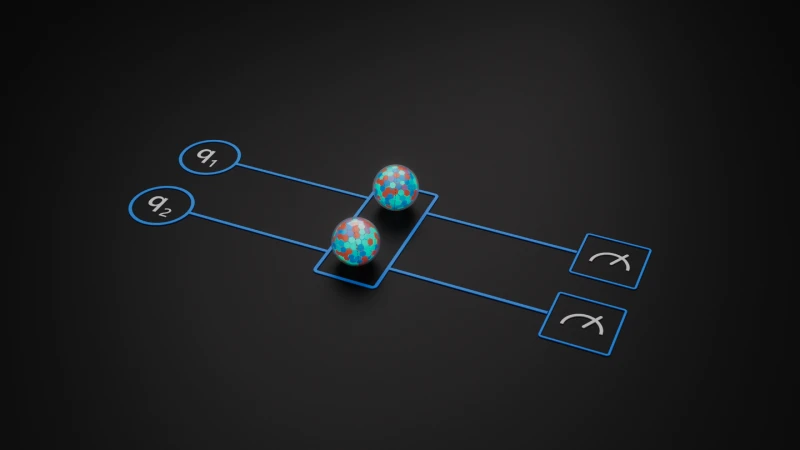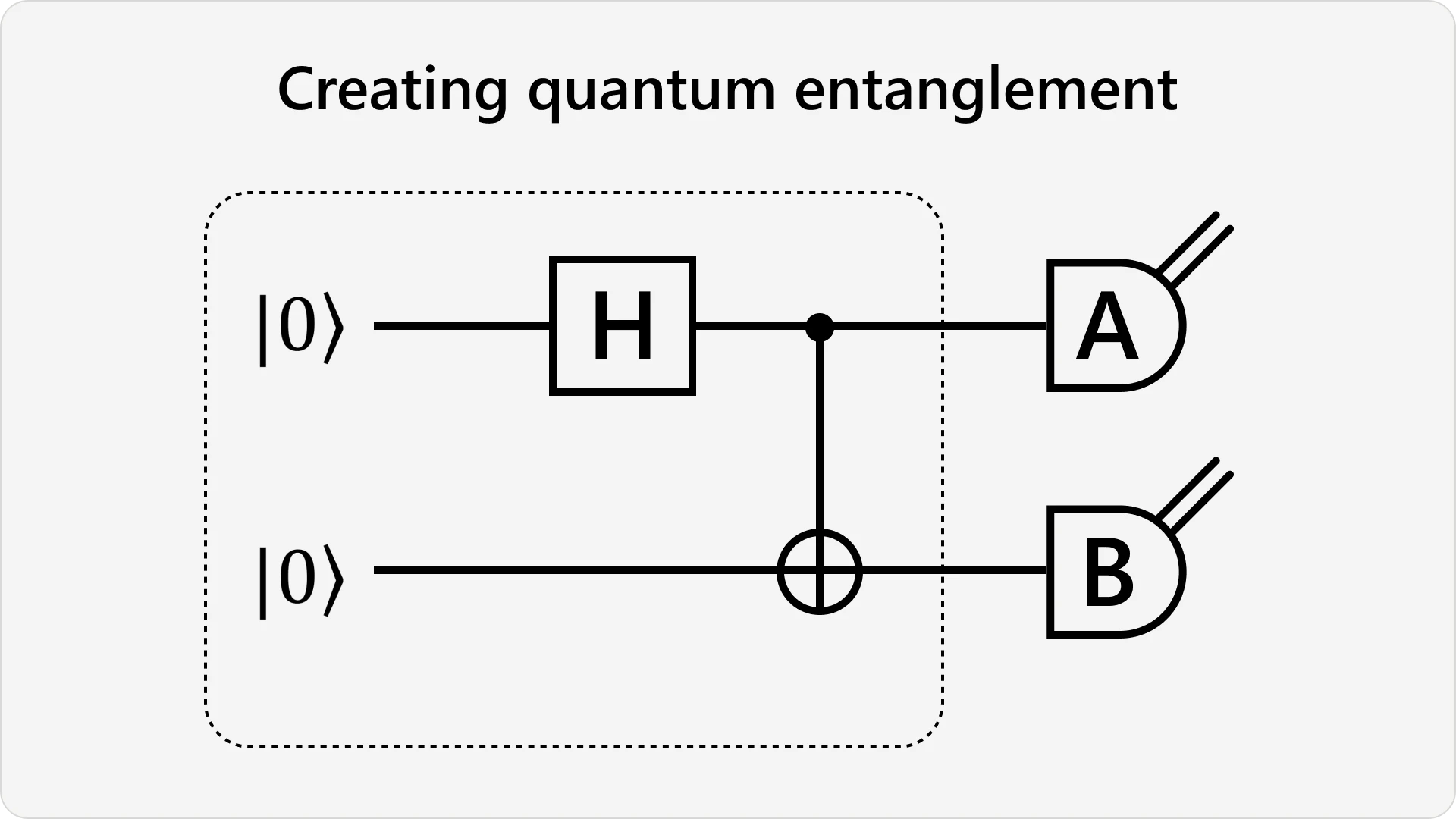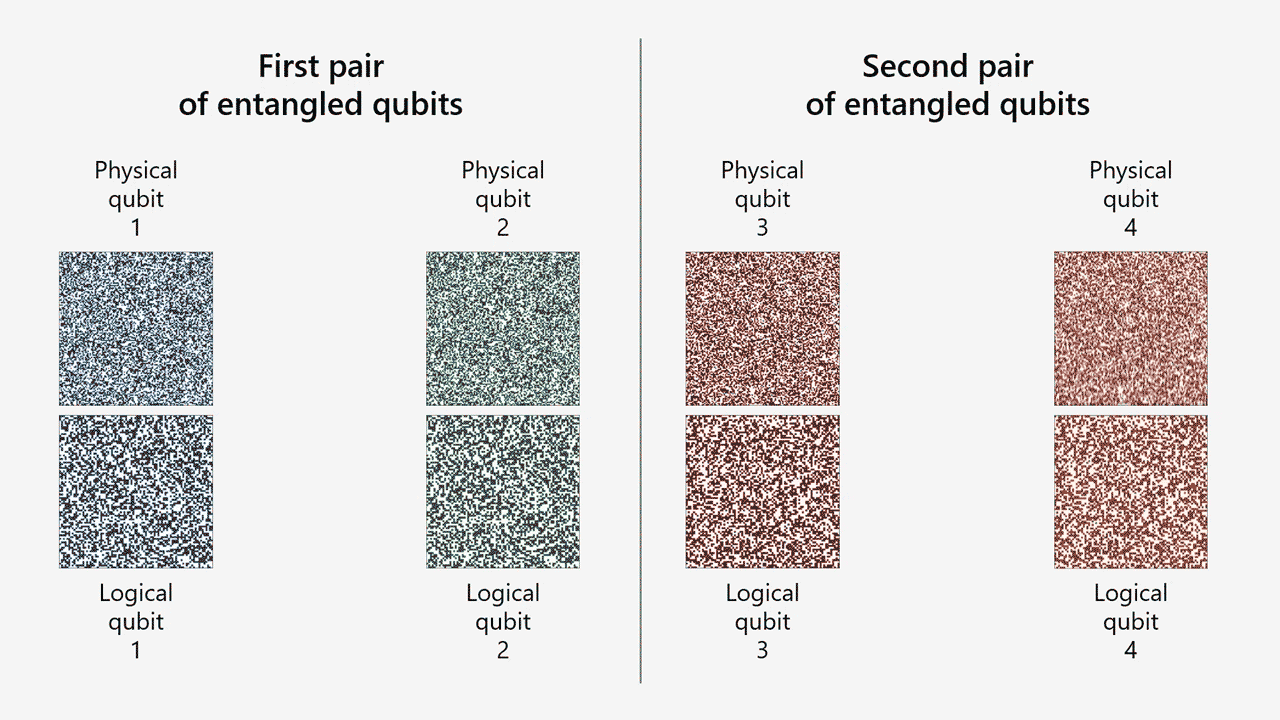By applying an innovative qubit-virtualization system to ion-trap hardware, Microsoft and Quantinuum were able to create four highly reliable logical qubits from only 30 physical qubits, while demonstrating an 800x improvement in error rate.

A hybrid supercomputer that combines both classical and quantum capabilities has the potential to solve formerly intractable problems and address the most pressing global issues. When powered by 100 reliable logical qubits, a hybrid machine could potentially solve scientific problems that are unsolvable on classical machines. To make this potential a reality, scientific and engineering breakthroughs are required. Today, Microsoft is announcing a critical breakthrough that advances the field of quantum computing by improving the logical error rate by 800x when compared to the error rate on corresponding physical qubits, thus creating the most reliable logical qubits to date.
Physical and logical qubits
Quantum computing uses qubits to store and process information. However, today’s qubits are prone to errors that limit their usefulness and the practicality of all noisy, intermediate-scale quantum computers. There are two approaches for reducing these errors:
- Improve the quality of the physical qubits and their operation.
- Use advanced techniques to combine multiple physical qubits into more reliable virtual qubits, which are often referred to as logical qubits.
Merely increasing the number of physical qubits with a high error rate—without improving that error rate—is futile because doing so would result in a large quantum computer that is not any more powerful than before. In contrast, when physical qubits with sufficient quality of operation are used with a specialized orchestration-and-diagnostics system to enable virtual qubits, only then does increasing the number of physical qubits result in powerful, fault-tolerant quantum computers able to perform longer, more complex computation.
Using qubit virtualization to create highly reliable logical qubits
The results presented here were achieved by coupling Microsoft’s qubit-virtualization system with Quantinuum’s specialized hardware. Quantinuum’s H-Series ion-trap qubits and unique Quantum Charged Coupled Device architecture have an excellent two-qubit gate fidelity of 99.8%. By applying our qubit-virtualization system to their qubits, we have been able to run 14,000 independent instances so far without a single error. Our sophisticated system has error diagnostics and corrections built in, allowing us to easily determine which errors need to be fixed and how to fix them.
With our qubit-virtualization system, we were able to create four highly reliable logical qubits from only 30 physical qubits of the available 32 on Quantinuum’s machine. When entangled, these logical qubits exhibited a circuit error rate of 10-5 or 0.00001, which means they would experience an error only once in every 100,000 runs. That is an 800x improvement over the circuit error rate of 8×10-3 or 0.008, measured from entangled physical qubits. This result was achieved through a combination of advanced runtime error diagnostics with computational run rejection and error correction. You can read more about our methods and results.
An 800x improvement in error rate corresponds to a 29 dB improvement of signal, which is the same as that achieved with a high-quality noise-canceling headset. To expand on that analogy, the environmental noise that exists on an airplane represents the noise level that the physical qubits exhibit. Activating the noise-canceling function on the headphones to listen to music, while removing most of the environmental noise, is akin to applying our qubit-virtualization system.
The 800x improvement was made possible through advances in Microsoft’s fault-tolerance protocols, which have been developed by our team over many years and involve careful design and optimization to greatly reduce both the number of physical qubits and the physical operations needed to produce reliable logical qubits. These results will improve further as we continue to optimize our methods.

Demonstration of active syndrome extraction
With the logical qubits we created, we were able to successfully perform multiple active syndrome extractions, which is when errors are diagnosed and corrected without destroying the logical qubits. Syndrome extraction is important because it permits longer and more complex computation to proceed without failure, which is necessary to achieve fault-tolerant quantum computing.
This achievement marks the first step in being able to correct errors while not destroying the logical qubits and showcases a fundamental milestone in quantum error correction. We demonstrated this critical component of reliable quantum computing with our qubit-virtualization system, which resulted in a low logical error rate over multiple rounds of syndrome extraction.
Reliable quantum computing
Three fundamental criteria to advance from noisy, intermediate-scale quantum computing to reliable quantum computing are:
- Achieve a large separation between logical and physical error rates.
- Correct all individual circuit errors.
- Generate entanglement between at least two logical qubits.
We have demonstrated, for the first time on record, that all three of the above criteria have been met. For the first criterion, we achieved an 800x improvement in logical error rate compared to the physical error rate. To quantify this 800x improvement, we entangled qubits and performed runtime error diagnostics and error corrections on the measurements (as seen in Figures 1 and 2), thus satisfying the second and third criteria.
In addition to meeting the three criteria above, we have demonstrated several rounds of active syndrome extraction on two logical qubits, which marks the transition to reliable quantum computing. This achievement is a prerequisite for building a hybrid classical-quantum supercomputer that outperforms even the most powerful classical computers.


Not all logical qubits have the same degree of usefulness and only those with very low error rates, such as those reported here, may reliably perform non-trivial computations. Integrating these highly reliable logical qubits, created with Quantinuum’s hardware and our qubit-virtualization system, into Azure Quantum Elements will provide a truly hybrid computing experience to users—one that combines the power of cloud high-performance computing with advanced AI models and improved quantum-computing capabilities.
Achieving reliable quantum computing is a notable milestone and will enable new capabilities and scientific discoveries as Microsoft’s qubit-virtualization system continues to improve. As we take advantage of these opportunities, we will continue to invest in technology that can scale to the level of hybrid supercomputing, which will require logical qubits that experience much less than one error for every 100 million operations. A hybrid supercomputer that combines classical and quantum capabilities could solve commercially significant problems that are far too complex for classical computers. To reach this level of quantum computing, Microsoft is developing a qubit with built-in error protection and digital control known as a topological qubit, and we have released results on recent advancements in that endeavor.
Learn more about Microsoft’s advancements and experience the power of quantum computing
- Read today’s announcement on highly reliable logical qubits on the Official Microsoft Blog.
- Read the full technical paper.
- Register for the Microsoft Quantum Innovator Series in April 2024 to discover how Microsoft and Quantinuum are collaborating to push the boundaries of quantum computing and enable new possibilities.
- Customers of Azure Quantum Elements can explore these new quantum capabilities in the coming months by signing up for a private preview.
